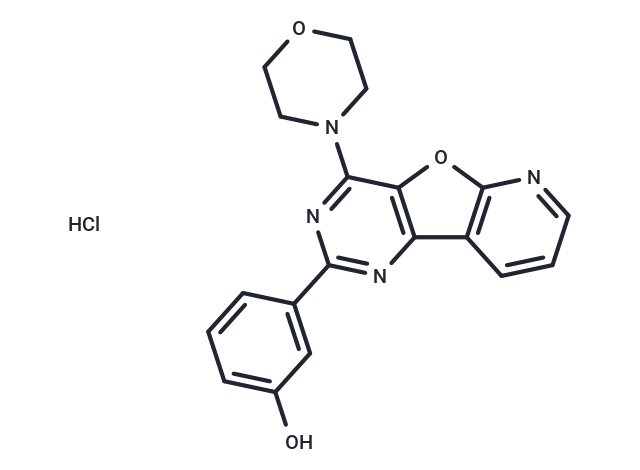Shopping Cart
Remove All Your shopping cart is currently empty
Your shopping cart is currently empty
PI-103 Hydrochloride is a dual PI3K/Akt and mTOR inhibitor exhibiting nM-level inhibition of p110α, p110β, p110δ, p110γ, DNA-PK, mTORC1, and mTORC2. PI-103 induces autophagy, mitochondrial apoptosis, and cell cycle arrest, making it suitable for leukaemia research.

| Pack Size | Price | USA Warehouse | Global Warehouse | Quantity |
|---|---|---|---|---|
| 2 mg | $34 | - | In Stock |
| Description | PI-103 Hydrochloride is a dual PI3K/Akt and mTOR inhibitor exhibiting nM-level inhibition of p110α, p110β, p110δ, p110γ, DNA-PK, mTORC1, and mTORC2. PI-103 induces autophagy, mitochondrial apoptosis, and cell cycle arrest, making it suitable for leukaemia research. |
| Targets&IC50 | mTORC1:20 nM, p110β:3 nM, p110δ:3 nM, p110γ:15 nM, mTORC2:83 nM, DNA-PK:23 nM, p110α:2 nM |
| In vitro | PI-103 Hydrochloride exhibits anti-proliferative properties in a panel of Homo sapiens cancer cell lines (including prostate cancer, ovarian cancer, glioblastoma, and oropharyngeal squamous cell carcinoma) as well as in Homo sapiens umbilical vein endothelial cells [1]. PI-103 Hydrochloride demonstrates dose-dependent inhibition of proliferation in 37-31E and 37-31E-F3 cells. For 37-31E cells, proliferation growth can be inhibited by 50% when the PI-103 Hydrochloride concentration exceeds 100 nM, whereas the concentration required to achieve 50% inhibition in 37-31E-F3 cells is 40±2 nM. In the 37-31E-F3 cell line, the inhibitory effects of PI-103 Hydrochloride at concentrations of 50 nM and 100 nM are comparable to those achieved with 500 nM PI-103 Hydrochloride in the 37-31E cell line [4]. |
| In vivo | An orthotopic xenograft model was established by subcutaneously injecting 37-31E-F3 melanoma cells into immunocompetent FVB/N wild-type mice. Subsequent drug administration to the mice showed the following results: PI-103 Hydrochloride (10 mg/kg) significantly promoted in vivo tumor growth, while sorafenib (50 mg/kg) inhibited tumor growth. Compared with sorafenib monotherapy, the combined treatment with the two drugs did not exhibit additional benefits in terms of tumor inhibitory effect; furthermore, the tumor volume in the combined treatment group was even slightly larger than that in the sorafenib monotherapy group [4]. |
| Synonyms | PI103 HCl |
| Molecular Weight | 384.82 |
| Formula | C19H17ClN4O3 |
| Cas No. | 371935-79-4 |
| Smiles | Cl.Oc1cccc(c1)-c1nc(N2CCOCC2)c2oc3ncccc3c2n1 |
| Relative Density. | no data available |
| Color | White |
| Appearance | Solid |
| Storage | store at low temperature | Powder: -20°C for 3 years | In solvent: -80°C for 1 year | Shipping with blue ice/Shipping at ambient temperature. | |||||||||||||||
| Solubility Information | DMSO: 3 mg/mL (7.8 mM), Sonication and heating are recommended. H2O: < 1 mg/mL (insoluble) | |||||||||||||||
Solution Preparation Table | ||||||||||||||||
DMSO
| ||||||||||||||||
| Size | Quantity | Unit Price | Amount | Operation |
|---|

Copyright © 2015-2025 TargetMol Chemicals Inc. All Rights Reserved.